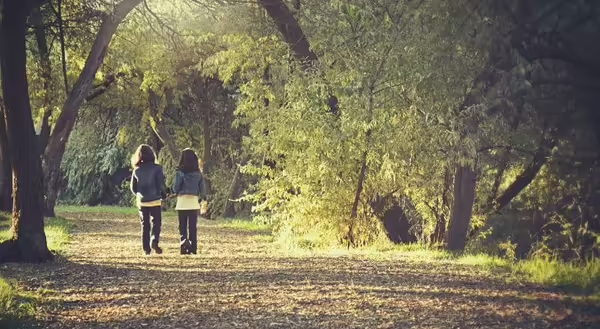
Spending time in nature is beneficial to our health and well-being.
It can improve our mood, make us feel more relaxed, help us be more active, and even connect us with our community. For children, time playing in nature is needed for healthy development. Don’t let the benefits of time outdoors end with summer. As youth return to school, help your family unwind and connect with nature, using one of these activities.
Give time and space for imaginative play.
Build a fairy home in the landscape using natural materials. Natural materials from plants (seeds, leaves, and dried flowers), trees (pinecones or sticks) and the earth (moss and rocks) bring to life a magical land filled with garden fairies and make-believe.
Find beauty in nature.
Take time together to explore the intricate details of an acorn top or delicate flower and create works of art from favorite finds. Incorporate the beautiful shapes and textures into mosaics, collages, jewelry, or cards. Display the family’s creations at home or encourage gift giving.
Build compassion for the Earth by supporting wildlife needs.
Building habitat for critters, like a bug hotel, provides shelter for overwintering pollinators or beneficial insects. Simple forms can be built with wood pallets, logs, or boxes, while dry natural material (leaves, sticks or straw, and pinecones) can divide the larger space into hotel “rooms”.
Unleash your inner animal on a hunt for animal tracks.
All animals leave a trace of their presence—sometimes intentionally, sometimes by accident. Large animals leave physical evidence we call tracks. Each species’ tracks has a distinctive footprint and pattern of steps. Let children study and mimic tracks to discover how the animal was moving (walking, running, jumping); to learn if they are big or small; and to guess how long ago they passed by.
Caring for the garden becomes caring for the planet.
Whether raking leaves or pulling the spent vegetables, delegating a small but valuable task to a young gardener offers little hands an opportunity to contribute in a meaningful way. Immediately after helping, and again in spring, identify how their contribution creates a healthier garden. Hearing that their role is important to the family, or the earth, lets your little steward learn how to affect positive change. Don’t forget the extra motivators, like a special snack, or a game! “Who can pull the biggest root or rake the biggest leaf pile?”
Engage the senses by planting colorful spring bulbs.
Plant bulbs in late September through October to allow a strong root system to form before winter. Spacing bulbs and measuring planting depths offer youth opportunities to practice important math skills. When planting bulbs, bury them two to three times deeper than the bulb length (measured from top to bottom).
Use a scavenger hunt to learn more about the world around you.
These hunts are the perfect way to get kids to explore a garden or nature place while also learning and practicing their observation skills. Create simple challenges that encourage kids to use all their senses. Also try prompts like outdoor ABCs, rainbow colors found in the garden, or even looking for wildlife. Take your hunt on the go – try it in a park or preserve!
ABOUT THE AUTHOR: Brittnay Haag is a Horticulture Educator with University of Illinois Extension, serving Livingston, McLean, and Woodford Counties. Her work focuses on youth horticulture education, specifically through school gardens and Jr. Master Gardener programs. Brittnay provides leadership for three county Master Gardener programs and is responsible for developing community programs and providing expertise in horticulture and environmental sciences.